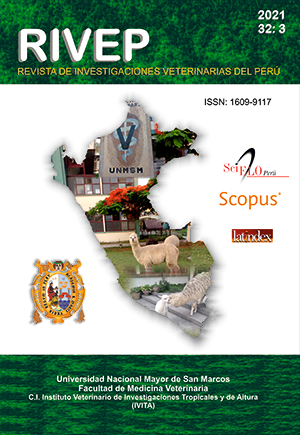Effect of Acacia macracantha on the physical and chemical properties of soil in a silvopastoral system
DOI:
https://doi.org/10.15381/rivep.v32i3.20389Keywords:
silvopastoral system, soil humidity, canopy, pastureAbstract
The aim of this study was to determine the effect of two ages of the long-spine acacia tree (Acacia macracantha) on the physical and chemical characteristics of the soil in a silvopastoral system with Guinea grass (Panicum maximum Jacq). The study was conducted in the Bellavista district, Cajamarca, Peru. The mechanical resistance, apparent density, humidity and temperature of the soil, as well as the content of organic matter, phosphorus (P2O5) and potassium (K2O) were evaluated in three soil locations: under the canopy of young (BCAj) and medium trees (BCAm) and outside the tree canopy (FCA), in two seasons of the year (dry and rainy). A complete randomized design with factorial arrangement 3 (location) x 2 (seasons) was used. Under the canopy of the medium trees, a lower soil temperature (27.96 °C) and higher soil humidity (15.23%) were found, in addition to improving soil fertility. The study made it possible to determine that the presence of trees in these silvopastoral systems improves the physical and chemical conditions of the soil, and generates a microclimate, improving environmental conditions.
Downloads
Downloads
Published
Issue
Section
License
Copyright (c) 2021 Gelver Romero Delgado, Fritz Trillo Zárate, Javier Orellana Chirinos, Pamela Quiroga Espilco, Jorge Gamarra Bojorquez, David Rojas Egoavil, Virginia Rivadeneira, Jimny Nuñez Delgado

This work is licensed under a Creative Commons Attribution 4.0 International License.
AUTHORS RETAIN THEIR RIGHTS:
a. Authors retain their trade mark rights and patent, and also on any process or procedure described in the article.
b. Authors retain their right to share, copy, distribute, perform and publicly communicate their article (eg, to place their article in an institutional repository or publish it in a book), with an acknowledgment of its initial publication in the Revista de Investigaciones Veterinarias del Perú (RIVEP).
c. Authors retain theirs right to make a subsequent publication of their work, to use the article or any part thereof (eg a compilation of his papers, lecture notes, thesis, or a book), always indicating the source of publication (the originator of the work, journal, volume, number and date).



